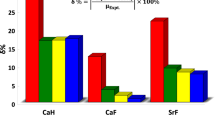Summary
The tight-binding model Hamiltonian originally proposed by Weaire and Thorpe for the diamond structure has been modified to describe the electronic states in helical-chain semiconductors, as trigonal Se and Te. The model, which takes account both of the intrachain and of the interchain bonds, depends on three parameters. These can be fitted in order to reproduce the main physical features of the band structure. As a possible application it is suggested the calculation of the dielectric matrix and of the magnetic susceptibility in these semiconductors.
Riassunto
L'hamiltoniano modello a legame stretto di Weaire e Thorpe, originalmente introdotto per cristalli aventi la struttura del diamante, è stato modificato allo scopo di descrivere gli stati elettronici dei semiconduttori a catene elicoidali, come il Se e il Te trigonali. Il modello, che tiene conto sia dei legami chimici nelle catene sia di quelli fra catene, dipende da tre parametri. Con una opportuna scelta di questi ultimi si possono riprodurre le principali caratteristiche fisiche della struttura a bande. Come possibile applicazione si suggerisce il calcolo della matrice dielettrica e della suscettività magnetica in semiconduttori di questo tipo.
Резюме
Гамильтониан в модели сильной связи, первоначально предложенный для структуры алмаза, модифицируется для описания электронных состояний в спиральных цепных полупроводниках, таких как ромбоэдрические Se и Te. Предложенная модель, которая учитывает связи внутри и между цепями, зависит от трех параметров. Эти параметры можно подогнать, чтобы воспроизвести основные физические особенности зонной структуры. Как возможное применение предлагается вычисление диэлектрической матрицы и магнитиой восприимчивости в этих полупроводниках.
Similar content being viewed by others
References
D. R. Penn:Phys. Rev.,128, 2093 (1962).
D. Weaire andM. F. Thorpe:Phys. Rev. B,4, 2508 (1971).
J. C. Slater andG. F. Koster:Phys. Rev.,94, 1498 (1954).
See, among many others,C. M. Bertoni, V. Bortolani, C. Calandra andE. Tosatti:Phys. Rev. B,9, 1710 (1974);P. E. Van Camp, V. E. Van Doren andJ. T. Devreese:J. Phys. C,9, L79 (1976).
H. Wendel, W. Weber andW. D. Teuchert:J. Phys. C,8, 3737 (1975).
H. Wendel:J. Phys. C,9, 445 (1976).
F. Nizzoli:Sol. State Comm. (in press).
M. Bensoussan:Journ. Phys. Chem. Sol.,35, 1661 (1974).
C. J. Bradley andA. P. Cracknell:The Mathematical Theory of Symmetry in Solids (Oxford, 1972).
P. Krusius, J. von Boehm andT. Stubb:Phys. Stat. Sol.,67 (b), 551 (1975).
R. Sandrock:Phys. Rev.,169, 642 (1968).
D. J. Chadi andM. L. Choen:Phys. Rev. B,8, 5747 (1973).
B. Kramer, K. Maschke andL. D. Laude:Phys. Rev. B,8, 5781 (1973).
Author information
Authors and Affiliations
Additional information
Переведено редакцией.
Rights and permissions
About this article
Cite this article
Nizzoli, F. Electronic states in trigonal Se and Te: A tight-binding model Hamiltonian. Nuovo Cim B 39, 135–146 (1977). https://doi.org/10.1007/BF02738184
Received:
Published:
Issue Date:
DOI: https://doi.org/10.1007/BF02738184




